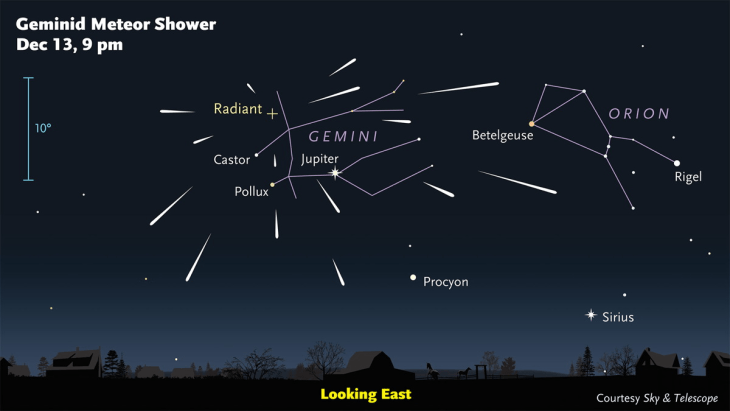Lovejoy's Tail suffers a disconnect.
.....
Geminid meteor shower set to peak, but moon might curtail viewing
Dec. 9, 2013 at 6:26 PM ET

SkyandTelescope.com
This chart shows the radiant point for the Geminid meteor shower.
This
week marks the peak of what is usually considered the most satisfying
of all annual meteor displays: the Geminid meteor shower.
As was the case with last month’s
Leonid meteor shower,
however, prospective skywatchers should be aware that once again,
observers will face a major obstacle in their attempt to see this year’s
Geminid performance, namely, the moon.
Unfortunately, as luck
would have it, the moon will turn full on Dec. 17, and as such, will
seriously hamper viewing the peak of the Geminids, predicted to occur in
the overnight hours of this Friday to Saturday. Bright moonlight will
flood the sky through much of that night, playing havoc with any serious
attempts to observe the usually spectacular meteor shower. [
See amazing photos of the 2012 Geminid meteor shower]
The
Geminids are already around, having been active only in a very weak and
scattered form since about Dec. 7. Geminid activity is expected to be
on an upswing in the nights to come, leading up to their peak on Friday
night.
Historically, this shower has a reputation for being rich
both in slow, bright, meteors as well as rather faint meteors, with
relatively few of medium brightness. Many
Geminid meteor shower
streaks appear yellowish in hue. Every once in a while, a Geminid
fireball will blaze forth, bright enough to be quite spectacular and
more than capable of attracting attention even in bright moonlight.
"If
you have not yet seen a mighty Geminid fireball arcing gracefully
across an expanse of sky, then you have not seen a meteor," astronomers
David Levy and Stephen Edberg wrote in their book, "Observe Meteors,"
published by the Astronomical League.
Dark sky opportunities
The
best times to look for streaking Geminids this year will be during the
predawn hours several mornings before the night of full moon when the
constellation Gemini will be standing high in the northwest sky.

Joe Rao / Space.com
l
times in this chart are a.m. and are local standard times. “MS” is the
time of moonset. “Dawn” is the time when morning (astronomical) twilight
begins. “Win” is the available window of dark sky composed of the
number of minutes between the time of moonset and the start of twilight.
In
fact, three “windows” of dark skies will be available between moonset
and the first light of dawn on the mornings of Dec. 13, 14 and 15.
Generally speaking, there will be about two hours of completely dark
skies available on the morning of Dec. 13. This window shrinks to only
about an hour on the 14th, and to less than 10 minutes by the morning of
the 15th.


